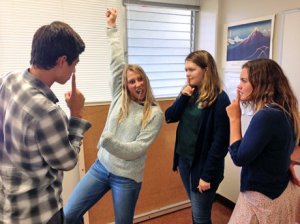Creating a Classroom Culture of Laughter
Start class with improv exercises to get students laughing together, demonstrate the rewards of risk-taking and failure, and model a listening, supportive environment.
Your content has been saved!
Go to My Saved Content.In the age of technology, when students use online databases for home research and when Khan Academy tutorials personalize learning, why does the 21st-century student come to school?
They come to see their friends. They come for the community. They come to be part of a classroom culture that motivates them to stick with the online tutorial and write that last paragraph in an essay.
For my first seven years of teaching, I spent the first week discussing class norms, dutifully posting group expectations on the wall, and asking that students sign an agreement to follow them in an effort to "determine class culture."
Turns out there's a quicker, more fun way to establish a positive atmosphere. With a little reinforcement, this positive culture lasts past the honeymoon of the first two weeks and into the second quarter when the gloves come off.
The secret is improv games. I call them warm-ups and play them once a week at the beginning of class. Many students tell me that warm-ups are the best part of their day. On one feedback form, Lacie wrote:

Day 1 Goals
- Getting students laughing with each other
- Showing that risk-taking is rewarded and failure is not punished
Eye Scream
Stand in a circle and look down at someone else's shoes. On the count of three, we'll all look up at the person whose shoes we chose. If that person is looking back at you, you both scream or yell out loud. Then heads go down and we play again.
Ten
Stand in a circle and look down at your own shoes. The goal is counting to ten as a group. No one can count two numbers in a row or talk at the same time as another person. If we make a mistake, the group just resets by kicking out one leg into the circle and saying, "Aoooggha!" like the horn of an old-timey truck. Then we start counting from one again. Too easy? Count to 20!
Day 2 Goals
- Showing that risk taking is rewarded
- Building listening into our class culture through mirroring back what the speaker has said.
Beep
Stand in a circle. I'll pass the beep to the person next to me, who'll pass it to the person next to her, etc. We pass the beep by looking at each other, breathing in together, and saying, "Beep" together as we exhale. It's harder than you think! Closely watch people's body language to read when they're going to say, "Beep." If you miss the joint beep, try again until you get it! Continue passing the beep until it goes around the circle.
One Word
Stand in a circle and think of your favorite word. It could be a small word like rain or a big word like pusillanimous. Think of a gesture to accompany your word. For rain, I let my fingers mimic raindrops. One at a time, we take turns saying our word and gesture to the person next to us, who passes it around the circle, each person mirroring what he or she saw and heard, until your word and gesture come back to you. Then we pass the next person's word.

Three-Sentence Story
Stand in a circle as we take turns making up a three-sentence story. The first person offers a beginning like, "Jack walked into the lunchroom." The second person, after listening, adds a middle sentence like, "His chocolate milk spilled all over the floor and wet his white shirt." The third person adds a conclusion like, "He laughed off this terrible case of the Mondays."
Day 3 Goal
- Building group dynamics of "yes and," meaning that you can take a risk and your group will support you in it.
Yes, Let's Do It!
Stand behind your chair for shouting out creative ways, popcorn style, to finish this phrase: "We should _______!" For example, "We should all ride a dragon!" or "We should brush our teeth!" or "We should high five our neighbor!" Whatever is said, as a class we respond, "Yes! Let's do it!" Then we act out doing that thing with wild enthusiasm until another "We should _______!" replaces it. I recently had an epic invisible ping pong game with a student, and it was so engrossing that no one shouted any more suggestions. You have to do whatever you shout out, so only suggest fun things.
Tableau
Invite five volunteers to the front of the room. They'll take turns striking any pose, and the other four will assume the same pose. This is mirroring. Once everybody's had a turn, we go through the line again, but this time, instead of mirroring, players try adding onto the human picture that the first person makes. So if student A starts off by sitting cross legged, student B could use his or her body to shade the meditator or lie down as a rug under student A's feet. Everyone adds onto the picture and holds their position. Then someone in the audience will give this human tableau a title like "A day at the ashram" or "Quiet moments" or "Can't stop meditating to blow my nose." Once the picture is titled, the volunteers go back to neutral.
After each game, I generally debrief a little by asking, "How did that feel?" or "How do the skills required in this game apply to our class?"
There are many more games out there. These are a few that my improv friend Michiline McManus taught me -- and they work well. Try them! Remember, if you mess up leading them, it is just excellent modeling for the students to see how you laugh it off and move on.
What warm-ups do you do in your classroom?
